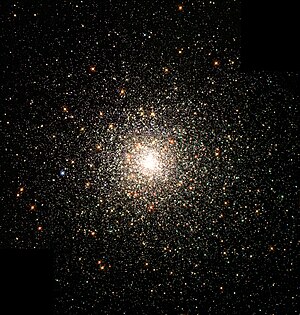Messier 80
|
Globular cluster Messier 80 |
|
|---|---|

|
|
| Photo from the Hubble Space Telescope | |
| AladinLite | |
| Constellation | Scorpio |
|
Position equinox : J2000.0 , epoch : J2000.0 |
|
| Right ascension | 16 h 17 m 02.5 s |
| declination | −22 ° 58 ′ 30 ″ |
| Appearance | |
| Concentration class | II |
| Brightness (visual) | 7.3 mag |
| Angular expansion | 10 ′ |
| Physical data | |
| Affiliation | Milky Way |
| Integrated spectral type | F6 |
| Redshift | +0.000024 ± 0.000014 |
| Radial velocity | (+7.3 ± 4.1) km / s |
| distance | 33 kLj (10 kpc ) |
| diameter | 96 ly |
| Age | 13 billion years |
| history | |
| discovery | Charles Messier |
| Discovery date | January 4, 1781 |
| Catalog names | |
| M 80 • NGC 6093 • C 1614-228 • GCl 39 • | |
The globular cluster Messier 80 ( NGC 6093 ), M 80 for short , is located in the constellation Scorpio south of the ecliptic .
The cluster is around 33,000 light years away from the solar system and has a maximum diameter of just under 90 light years . Its distance to the galactic center is 12,500 ly. It orbits the Milky Way system on a steeply inclined orbit; one orbit takes about 70 million years. Its age is estimated to be 13 billion years. The mass density in the central area is around 5.7 solar masses per cubic parsec , making M 80 one of the densest globular clusters in the Milky Way.
M 80 is relatively easy to find in the starry sky because it is not far from the bright stars Antares (α Scorpii) and δ Scorpii .
There is a surprisingly large number of hot blue stars (" blue stragglers ") in M 80 , which normally only occur in regions with a high starburst rate . It is believed that they are formed when two smaller stars collide and then merge. Such collisions are practically impossible in normal regions of a galaxy, but in globular clusters the star density is thousands or tens of thousands of times higher. More than twice as many blue stragglers were found in M 80 as in any other globular cluster examined.
Appearance
M 80 is one of the weaker and smaller globular clusters in the Messier catalog. In the prism binoculars it appears as a round, misty spot. With a telescope with an opening of 4 cm or more, the edge area can be broken down into individual stars.
Observation history
M 80 was discovered by Charles Messier in 1781 . Pierre Méchain observed him in the same year.
On May 21, 1860 a Nova appeared in M 80, which was named T Scorpii . The nova had a brightness of 7.0 mag on that day and was thus significantly brighter than the entire star cluster. On June 16, the nova had already subsided to 10.5 mag.
Web links
swell
- ↑ NASA / IPAC EXTRAGALACTIC DATABASE
- ↑ Harlow Shapley, Helen B. Sawyer: A Classification of Globular Clusters . In: Harvard College Observatory Bulletin . tape 849 , 1927, pp. 11-14 , bibcode : 1927BHarO.849 ... 11S .
- ↑ SEDS : NGC 6093
- ↑ a b Messier 80 at SEDS
- ↑ a b Seligman
- ↑ Stars and Space June 2007 p. 66

